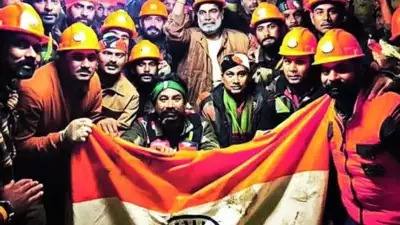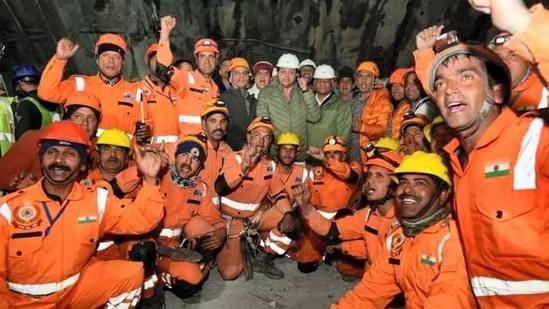Life At The End Of The Tunnel: A Daring Rat-hole Miner’s Risky Task
The rescue of 41 workmen trapped inside the Silkya tunnel in Uttarkashi was a success. PMO and NDRF officials supported the 17-day multi-agency initiative. The trapped workers were safely rescued, with the first, Vijay Horo, being transported out on a stretcher. CM Pushkar Singh Dhami and Union Minister Gen. VK Singh greeted the workers. A slight earthquake caused debris to shift, a loud cracking sound halted work, and the danger of tunnel face collapse were all challenges. A physical test revealed that the workers were healthy.
WFY BUREAU INDIA: After days of ups and downs and waves of hope and despair, the multi-agency mission to rescue 41 workers trapped inside the Silkyara tunnel in Uttarkashi finally succeeded on 28th (December) evening, when all of them were safely hauled out. The colossal operation, unmatched in its scope and ambition, brought an end to a 17-day nightmare in which the whole government apparatus, including the PMO, threw its weight behind the evacuation drill.

When the first trapped worker, Vijay Horo, was taken out on a stretcher by NDRF personnel at 7.28 p.m., emotions ran high and shouts erupted among the rescue workers, who had literally lifted mountains to get the guys out.
Earlier, at 7.12 p.m., a team of doctors and NDRF men entered the tunnel in accordance with a pre-determined SOP. The tired but stoic workers were greeted with garlands by CM Pushkar Singh Dhami and Union Minister of State for Road Transport and Highways Gen VK Singh (retd) after the final stage of the mission, which lasted just over an hour.
“It was an unprecedented operation,” claimed Anurag Jain, secretary of MoRTH. Access to electricity, water, and adequate room for the confined workers were key points in our favour. As a result of establishing the supply connection, the situation became more controllable.”
When discussing the difficulties, he noted that a little earthquake on November 16 caused the debris within the tunnel to shift 3 inches. Further, “a loud cracking sound the following day panicked the workers, leading us to halt the work for three days.”
According to Jain, specialists predict that “the tunnel face could collapse, posing a significant setback to the entire operation.” As a result, we made the decision to develop numerous measures in case such an incident occurred.
On Tuesday 28th December, evening, a rapid physical test was done for the workers inside the main tunnel itself, where a team of 28 medical personnel, including 15 doctors, chemists, and ward boys, was stationed. “All of the workers were determined to be physically fit. The majority of them had elevated blood pressure, which was attributed to anxiety from being in such a condition for so long. “Anti-anxiety pills were given to them,” claimed one of the doctors who did the examination.
Later, the Chief Minister, Dhami declared that each worker would receive Rs 1 lakh in financial aid. He said that the state government would cover all of their medical expenses and that he would ask NHIDCL, the tunnel project’s executing agency, to grant them 15 to 20 days of leave to let them return to their various states.
The final portion of the rescue, which lasted more than 40 hours, proved to be a test of will and stamina for everyone on both sides of the 57 metres of rubble (behind which the workers were trapped).
The most serious setback was the failure of the auger equipment designed to drill an escape tunnel through the debris. The machine’s blades became trapped in the channel on Friday, causing rescue attempts through the main tunnel route to come to a halt for more than 60 hours. Most of them thought that it is our misfortune, and now only a miracle from God can bring about a change.
The “miracle” that everyone was looking for was realised by a group of small labourers known as “rat-hole” miners. They were called in to manually dig through the last 12 metres of debris after the auger machine parts were cleared from the escape path.
After starting work on Monday evening, the ‘rat-hole’ miners, armed with shovels and spades, had dug through the final stretch of detritus by Tuesday morning, accomplishing in less than 24 hours what drilling machinery had been unable to do for several days.
After that, rescue teams were able to push within 800mm of welded-together pipes, which acted as an escape tunnel via which the stranded workers eventually emerged.

Who is Munna Qureshi, the hero of the Uttarakhand tunnel rescue operation?
The rat-hole miners made a breakthrough in the Uttarkashi rescue mission when Munna Qureshi became the first miner to approach the trapped men.
The major 17-day rescue operation in the Silkyara tunnel finished successfully on Wednesday, as all 41 workers walked out of the entrapment safely. The rescuers were in the spotlight, receiving all the accolades for their tireless hard work and resilience. In his statement, Prime Minister Modi praised the spirit of all those participating in the rescue operation, saying that everyone involved in the mission provided a great example of humanity and teamwork. Although rat-hole miners completed the final mile of the Uttarakhand tunnel, numerous government agencies with sizable personnel were on duty 24 hours a day, seven days a week. Munna Qureshi, who was the first to approach the workers, has been praised as the operation’s hero.
Following the successful completion of the rescue mission, rescue officials met with Uttarakhand Chief Minister Pushkar Singh Dhami and Union Minister of State VK Singh.
Munna Qureshi, 29, is a rat-hole miner for a Delhi company that provides trenchless engineering services to clean sewer and water lines. He was one of dozens of rat-hole miners brought to Uttarakhand on Monday to clear the last 12 metres of debris.
After the US-made auger machine failed and had to be pulled from the trench, rat-hole miners became the last resort of the rescue mission. Rat-hole mining is a way of extracting coal by excavating small holes; however, it was outlawed as a coal-extracting method in 2014 due to its unscientific nature.
Munna Qureshi said he observed the 41 trapped workers when he lifted the last rock on Tuesday evening. “They hugged me, cheered in applause, and thanked me profusely,” Munna Qureshi explained.
The other rat-hole miners who eventually reached the stranded men were Monu Kumar, Wakeel Khan, Feroz, Parsadi Lodhi, and Vipin Rajout. The men inside, who had been waiting for a long time for a break from the other side, screamed in joy and raised the miners. “They gave me almonds,” stated one of the miners. The miners remained there for 30 minutes before the NDRF arrived to rescue the trapped men.
Bundelkhand in Uttar Pradesh is home to ‘rat-hole miners.’
Jhansi, located in the historic Bundelkhand region, has recently brought its ‘rat-hole miners‘ to the forefront, highlighting their crucial role in the most difficult situations.
Beyond simple headlines, these expert individuals displayed their prowess by rescuing 41 people from a clogged tunnel in Uttarakhand, adopting procedures that echoed a centuries-old tradition. When a cutting-edge US-made auger machine failed, the ‘rat-hole’ mining experience came to the rescue. With only hammers, trowels, and shovels as weapons, a group of six skilled “rat miners” from Jhansi joined forces with the Indian Army, NDRF, and SDRF rescue teams. They succeeded in breaching the rugged terrain, bringing trapped miners to safety after a terrible 17-day ordeal.
Colonel Deepak Patel, who led the Silkier rescue operation, stressed the importance of teamwork, emphasising the critical role played by these “rat miners” in critical moments. “It was the result of everyone’s collective efforts; every rescue worker contributed significantly to it, and the role of the “rat miners” was definitely decisive at the last minute.””
Rat-hole mining, which has a long history, entails manually extracting materials through narrow horizontal channels. This approach was historically important in the construction of 16th-century temples in the Bundelkhand region, which is known for its historical structures, forts, and temples.
The frequency of rat-hole mining in Jhansi is ascribed to the city’s mountainous plateau with hard granite bedrock, which makes conventional drilling difficult. Earth scientists observe that rock cutters use this archaic technology to produce wells and ponds when explosives cannot be used because of the hard rock composition.
According to local reports, ‘rat miners,’ also known as ‘khagars,’ come from a variety of communities. Their competence ranges from quarrying to underpass construction, as well as pond construction, and they use instruments such as hammers and shovels.
From obscurity to centre stage
- Rat miners, also known as ‘khagars’ in the Bundelkhand region, originate from a variety of communities, including Ahirwar, Kushwaha, Lodhi, Sahariya, and Koris.
- Six Jhansi rat miners, armed with hammers, trowels, and shovels, assisted in the rescue effort.
Rat-hole mining is a family business.
- Rat-hole miners may crush rocks up to 10 quintals with hammers and shovels.
- Rat-hole mining was employed to build temples in the Bundelkhand region in the 16th century.




